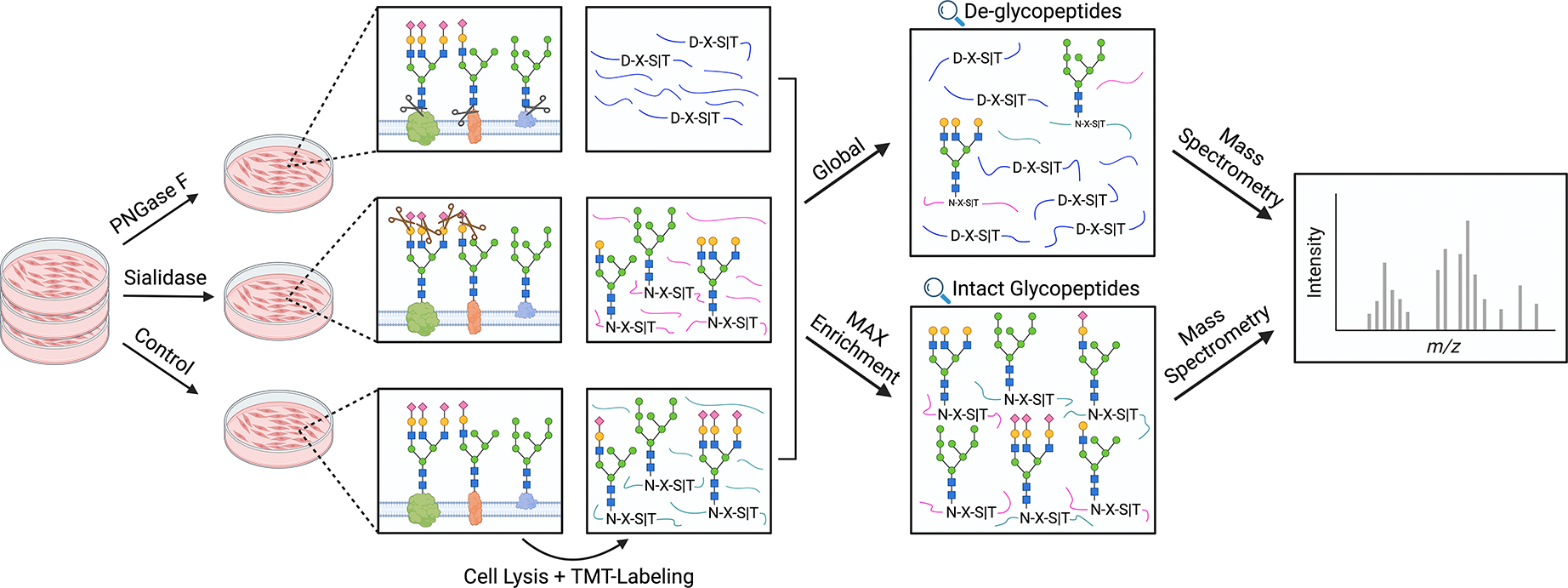Glycoprotein Analysis Service
At MtoZ Biolabs, the Glycoprotein Analysis Service combines optimized biochemical preparation, advanced separation strategies, and state-of-the-art mass spectrometry platforms to deliver comprehensive characterization of glycoproteins. Our service portfolio includes structural analysis of intact glycoproteins, detailed N- and O-glycan profiling, and site-specific glycosylation mapping to reveal occupancy, heterogeneity, and glycoform distribution. By integrating robust glycopeptide enrichment approaches with high-resolution LC-MS/MS and MALDI-MS, we ensure sensitive detection of both high- and low-abundance glycoproteins in complex biological or pharmaceutical samples. Additionally, our dedicated bioinformatics pipelines provide accurate structural annotation and quantitative analysis, enabling clients to uncover molecular mechanisms, evaluate therapeutic protein quality.
Overview
Glycoproteins are fundamental biomolecules that integrate protein backbones with structurally diverse glycans, creating a layer of molecular complexity that influences virtually every aspect of cellular biology. Their glycosylation patterns dictate protein folding, trafficking, and stability, while also modulating receptor interactions, immune recognition, and signaling cascades. Subtle variations in glycosylation, even at a single site, can profoundly alter biological function, therapeutic efficacy, or disease pathology.
The structural heterogeneity of glycoproteins presents a major analytical challenge, as glycoforms differ in composition, branching, linkage, and occupancy. Traditional biochemical methods provide only limited resolution, making advanced mass spectrometry-based strategies indispensable for accurate characterization. Modern glycoprotein analysis integrates sensitive sample preparation, targeted glycopeptide enrichment, and high-resolution LC-MS/MS to unravel this complexity at both the global and site-specific levels.
Technical Principles
Glycoprotein analysis is fundamentally based on mass spectrometry (MS) combined with tailored biochemical preparation and enrichment strategies. Proteins carrying glycans are first digested into peptides and glycopeptides using specific proteases. Since glycopeptides are usually low in abundance and structurally diverse, enrichment methods such as lectin affinity chromatography, hydrophilic interaction chromatography (HILIC), or hydrazide chemistry are applied to selectively isolate glycopeptides.
High-resolution LC-MS/MS is then employed to acquire detailed information on both the peptide backbone and glycan moieties. Fragmentation techniques, including higher-energy collisional dissociation (HCD), electron-transfer dissociation (ETD), or combined methods, provide complementary spectra for identifying glycosylation sites and characterizing glycan structures. Finally, advanced bioinformatics pipelines integrate spectral interpretation with curated glycan databases, enabling precise mapping of glycosylation sites, glycoform heterogeneity, and structural annotation.

Lin DC. et al. Anal Chem. 2024.
Figure 1. Workflow of cell surface glycoprotein identification using enzymatic treatment and mass spectrometry
Analysis Workflow
The general analytical workflow for the Glycoprotein Analysis Service is as follows:
1. Protein Extraction and Preparation
Proteins are isolated from biological or pharmaceutical samples under optimized conditions to preserve glycosylation.
2. Enzymatic Digestion
Proteins are digested with proteases such as trypsin to release glycopeptides while maintaining site-specific glycan information.
3. Glycopeptide Enrichment
Enrichment techniques such as lectin affinity chromatography, hydrophilic interaction chromatography (HILIC), or hydrazide chemistry are applied to selectively capture glycopeptides.
4. LC-MS/MS Analysis
High-resolution liquid chromatography–mass spectrometry is used to characterize peptide backbones and attached glycans through complementary fragmentation methods.
5. Data Processing and Annotation
Bioinformatics pipelines identify glycosylation sites, annotate glycan structures, and quantify glycoform heterogeneity to generate comprehensive glycoprotein profiles.
6. Reporting
Provide a complete report including experimental procedures, raw data and data analysis.
Service Advantages
1. Comprehensive Characterization
Glycoprotein Analysis Service enables simultaneous identification of glycoproteins, glycosylation sites, and glycoform distributions, providing a complete view of glycoprotein heterogeneity.
2. High Sensitivity and Accuracy
Advanced LC-MS/MS platforms combined with optimized enrichment workflows ensure reliable detection of low-abundance glycopeptides with precise structural annotation.
3. Flexible Analytical Strategies
Multiple enrichment techniques and fragmentation methods can be tailored to the complexity of different sample types and research objectives.
4. Robust Bioinformatics Support
Dedicated pipelines integrate curated glycan databases for accurate site mapping, quantitative analysis, and functional annotation.
Sample Submission Suggestions

It is recommended to contact our technical support team before submitting samples to determine sample suitability and obtain tailored submission guidelines.
Applications
Applications of the Glycoprotein Analysis Service include but are not limited to:
1. Biosimilar Development
Comparing glycosylation profiles between biosimilar candidates and reference biologics to ensure regulatory compliance.
2. Disease Biomarker Identification
Profiling glycoproteins in clinical samples such as serum, plasma, or tissue to discover biomarkers for cancer, autoimmune disorders, and neurodegenerative diseases.
3. Vaccine Development
Analyzing glycosylation of viral and bacterial surface proteins to assess immunogenicity and guide rational vaccine design.







